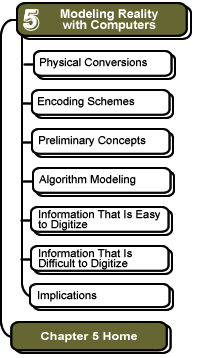

Implications of Digitizing the World
| What we have to do is identify the proper place of computer technology. Instead of allowing it to render our responsibility superfluous, we have to realize that it increases our responsibility. Egbert Schuurman. Perspectives on Technology and Culture. Sioux Center, IA: Dordt College Press, 1995 |
Bits can represent almost anything! This is a very powerful concept; not because bits are so special (they are just 1s and 0s after all), but because we can define how to interpret bits as we see fit. Bits can be commands, numbers, images, sounds, activities, letters, and so forth, all depending on our interpretation. This is not unlike spoken and written language. For example, the word table is dependent on interpretation—we might mean an object with a flat surface standing on four legs (more or less), or we might mean an arrangement of rows and columns on a page with entries of text or numbers. Our computer bits are similarly dependent on the context. The bits must be interpreted by the computer. Sometimes we have to give the computer a hint by specify which program to use when interpreting the bits. We might do this by responding to a dialog prompt from the computer operating system that asks which program should be used to open a file. We might also give a hint by naming a file with a special extension (such as .doc or .txt) that tells the operating system which program to use as the interpreter.
The type of information or knowledge we can represent with bits is limited only by our own imagination in developing the appropriate interpretation and implementing it in a computer program. Of course, human imagination is tainted by the effects of sin. The Reformed tradition of Christianity views the history of the universe in three stages: creation, fall, redemption. The fall means that even our computer programs will suffer the ill effects of sin. However, as Christians we can work to redeem the creation in Christ's name. That means engaging the world, including the world of computers, in an effort to identify and celebrate that which is good and reject that which is sin. Because they are used as a representation that must be interpreted, computer bits are not neutral from an ethical standpoint. That interpretation, implemented by human programmers, will be warped by sin. For example, we can recognize this effect by insisting that no program can ever be foolproof or perfect. On the other hand, a computer program can serve as a tool to help us celebrate God's goodness if it helps us better to understand the inner workings of a molecule or a weather system.
As we use the computer as a tool to analyze complex systems, to understand processes and interactions, to predict the future behavior of an ecosystem or a weather system, we must take care. If users rely on the computer for all the answers, without understanding the algorithm (and the model, the input, the precision, the method, etc.), then they are little more than data-entry clerks—having little ability to recognize valid results, not understanding how to adapt the design, and adding little value to what the programmer who wrote the software already has done. Knowing how to "push the button" takes very little training. Knowing which button to push, how often, with what expectations, and when to trust the result requires an education in fundamentals and a modest depth of experience in the field. The computer (at least for today) cannot replace the human being. It is a powerful tool, among many, at the disposal of the scientist, engineer, sociologist, and historian (to name a few). It can be used to improve efficiency, accuracy, creativity, reliability, and understandability. It can also waste time, stifle creativity, distort reliability, and obscure information. Our task is to learn how to maximize the advantages while minimizing the dangers. That challenging task is simply part of the redemptive, transformational process that all Christians are engaged in (but perhaps Christians in the Reformed tradition in particular).
![]()
![]()
These pages were written by Steven H. VanderLeest and Jeffrey Nyhoff and
edited by Nancy Zylstra
©2005 Calvin University (formerly Calvin College), All Rights Reserved
If you encounter technical errors, contact computing@calvin.edu.